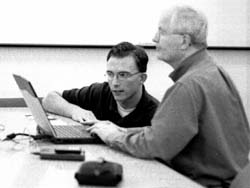One small step for man, one giant leap for Utah State University
Plans are underway to get Utah State University experiments on the International Space Station (ISS).
Andrew Auman is the coordinator for USU’s Get Away Special (GAS) team, which designs, builds and flies experiments, or payloads, in space.
At a colloquium Tuesday, Auman highlighted USU’s position in a program likely to give the university world-wide recognition.
In June, Auman flew to the Goddard Space Flight Center near Washington D.C. to represent USU at NASA’s 20th Year GAS Anniversary Conference. He gave an hour-long presentation on USU’s GAS history.
The most exciting news from the conference was that NASA’s Shuttle Small Payloads Project is working with Swales Aerospace to develop a new program called FAST, which will allow instititutions the opportunity to place experiments on the ISS for three to six months.
“With its background … USU has the potential of placing the first FAST payload on the International Space Station,” Auman said. “When the fast program happens, that will be huge, and huge is an understatement.”
Already, USU’s team has put three or four times as many payloads in space as any other educational institution in the world, including Harvard University, MIT, Penn State, “you name it,” he said.
Furthermore, USU is only one payload away from equaling the number NASA’s Shuttle Small Payloads Project has flown, Auman said.
A big part of USU’s space heritage was launched when its original GAS team sent the first payload ever aboard the space shuttle Columbia in 1982. USU experiments were also first on the K-Bird, or “vomit comet,” NASA’s parabolic flight campaign, which allows students to perform experiments in 25-second intervals of weightlessness. This airplane was used in movies such as “Apollo-13” and “Armageddon,” Auman said.
In one and one-half to two years, the FAST program will be yet another example of the precedent USU has set for being first in space.
“We’re going to build an experiment and basically go to NASA and say ‘it’s sitting here on the table for you whenver you’re ready,'” Auman said.
The GAS team plans to ask private and government institutions for the money needed to set the project in motion. Auman said he hopes the FAST experiments will carry price tags similar to GAS payloads.
One 2.5-foot cylinder payload with a 100-pound weight limit costs educational institutions about $5,000 and private industries $14,000, Auman said.
The university allots $5,000 from the budget to the GAS team each year, but that will all go toward the continuation of payload work. FAST will require another $5,000, if not more, he said.
“If we can get the financial backing we need, the enthusiasm is there, and we’ll be ready to go,” he said.
Not only will the GAS team have cause for enthusiasm, but USU will, too.
“It’s great for the university because of the publicity,” Auman said.
Flint Hamblin, a physics student, said some in the aerospace industry have labeled USU “Utah Space University.”
“Contrary to popular belief, it’s not because there are no parking spaces,” he said.
USU’s space research started more than 20 years ago. During the mid-70s, what are now known as the Space Dynamics Laboratory and Center for Atmosphere and Space Sciences were being born.
USU’s first GAS payload was donated by R. Gilbert Moore, an executive at Thiokol. Ten experiments, ranging from fruit fly genetics to thermal conductivity, were crammed into one 5-cubic-foot canister.
Other GAS experiments have explored things like photosynthesis in micro-gravity and distillation in space. Joint efforts with Edith Bowen Elementary School have tested if radish seeds and popcorn exposed to space would taste or grow differently.
Jan Sojka, GAS team adviser, said “Although many experiments fail, they provide participants with invaluable experience in design, creation, analysis of data and teamwork.”
Most experiments are done on a minimal budget with parts from Radio Shack, he said.
Students who have ideas for experiments or would like to join the GAS team can visit its Web site, http://gas.physics.usu.edu, or attend its meetings Tuesdays at 5 p.m. in the Science Engineering Resource Building, Room 244.
-sl2cw@cc.usu.edu
-amarie@cc.usu.edu

Andrew Auman and Vincent Wickwar, physics professor, plan for the GAS seminar. (Photo by Michael Sharp)

